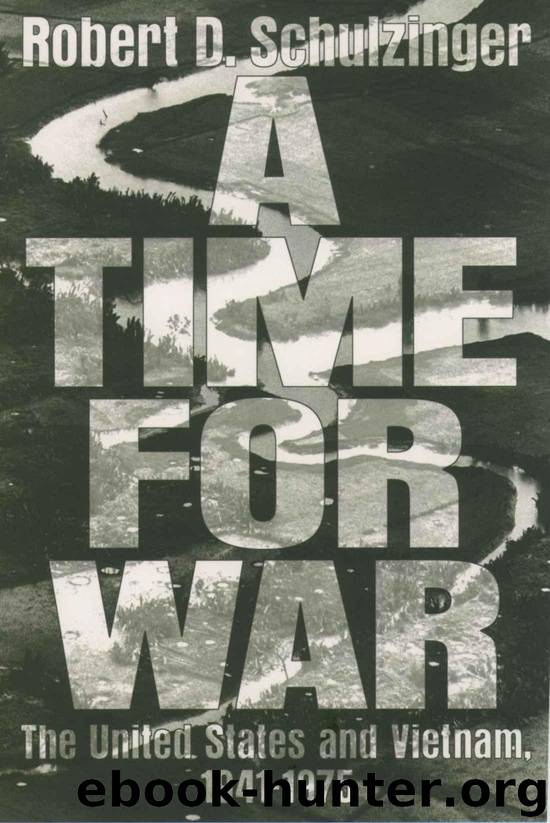A Time for War: The United States and Vietnam, 1941-1975 by Robert D. Schulzinger

Author:Robert D. Schulzinger [Schulzinger, Robert D.]
Language: eng
Format: epub
Publisher: Oxford University Press
Published: 1997-05-01T06:00:00+00:00
THE AIR WAR
Even as the U.S. army tried to engage the Vietcong and North Vietnamese in large scale ground operations, the air war over the North went forward. When the Johnson administration embarked on the Rolling Thunder bombing of North Vietnam in February 1965, planners expected that the bombing campaign would buy time for the government of the South.76 Planners hoped that a revitalized South Vietnamese government might take more initiative.
By June 1965, Johnson’s principal military advisers concluded that Rolling Thunder alone would not stabilize the military situation in the South. By the end of July Johnson decided on an additional forty-four battalions of troops for South Vietnam, and the role of the bombing of the North changed. Now bombing was to combine political initiatives designed to bring North Vietnam to the bargaining table with the physical destruction of the North’s ability to fight the war.
For the remainder of 1965 Rolling Thunder attacks averaged about 750 sorties per week. For the entire year U.S. bombers and fighters flew about 55,000 sorties over the North. About half of these were attacks, and the rest reconnaissance or rescue missions. These missions over the North represented about 30 percent of the total amount of U.S. air actions in Southeast Asia.77 In late July 1965 McNamara argued that air raids would put “a ceiling on the size of the war that the enemy can wage.”
But McNamara seemed more interested in the political aspects of the bombing of the North. He outlined the principles behind the bombing designed to encourage the North to negotiate while avoiding the risks of a larger war. He wanted the United States to emphasize the threat to the North of the potential for future attacks against it, and encouraged Johnson to allow the North Vietnamese to save face. The best way to encourage the North Vietnamese to negotiate on American terms was to design the bombing program in a way which allowed for pauses, since the North could more easily open discussions when bombing of their territory was not taking place. McNamara believed that the most effective military impact of the bombing campaign would be to prevent the flow of supplies and men (known as “interdiction” in military parlance) from the North to the South. In terms of starting negotiations to end the war, he thought it essential to “avoid bombing which runs a high risk escalation into war with the Soviets or China and which is likely to appall allies and friends.”78
As the bombing of the North continued in the years after the decision to Americanize the war, the campaign followed rubrics McNamara had laid down. McNamara and Johnson kept off limits major targets such as bridges, port facilities, power plants, and munitions factories in the Hanoi-Haiphong area. They wanted to make the North Vietnamese constantly worry that the United States might in the future attack the most industrially advanced areas of the North. Initially Johnson fully supported McNamara’s program of gradual escalation and political incentives. Later, however, McNamara’s
Download
This site does not store any files on its server. We only index and link to content provided by other sites. Please contact the content providers to delete copyright contents if any and email us, we'll remove relevant links or contents immediately.
| Arms Control | Diplomacy |
| Security | Trades & Tariffs |
| Treaties | African |
| Asian | Australian & Oceanian |
| Canadian | Caribbean & Latin American |
| European | Middle Eastern |
| Russian & Former Soviet Union |
The Secret History by Donna Tartt(18947)
The Social Justice Warrior Handbook by Lisa De Pasquale(12168)
Thirteen Reasons Why by Jay Asher(8846)
This Is How You Lose Her by Junot Diaz(6833)
Weapons of Math Destruction by Cathy O'Neil(6215)
Zero to One by Peter Thiel(5733)
Beartown by Fredrik Backman(5679)
The Myth of the Strong Leader by Archie Brown(5457)
The Fire Next Time by James Baldwin(5382)
How Democracies Die by Steven Levitsky & Daniel Ziblatt(5172)
Promise Me, Dad by Joe Biden(5113)
Stone's Rules by Roger Stone(5052)
A Higher Loyalty: Truth, Lies, and Leadership by James Comey(4906)
100 Deadly Skills by Clint Emerson(4880)
Rise and Kill First by Ronen Bergman(4739)
Secrecy World by Jake Bernstein(4700)
The David Icke Guide to the Global Conspiracy (and how to end it) by David Icke(4657)
The Farm by Tom Rob Smith(4465)
The Doomsday Machine by Daniel Ellsberg(4449)
